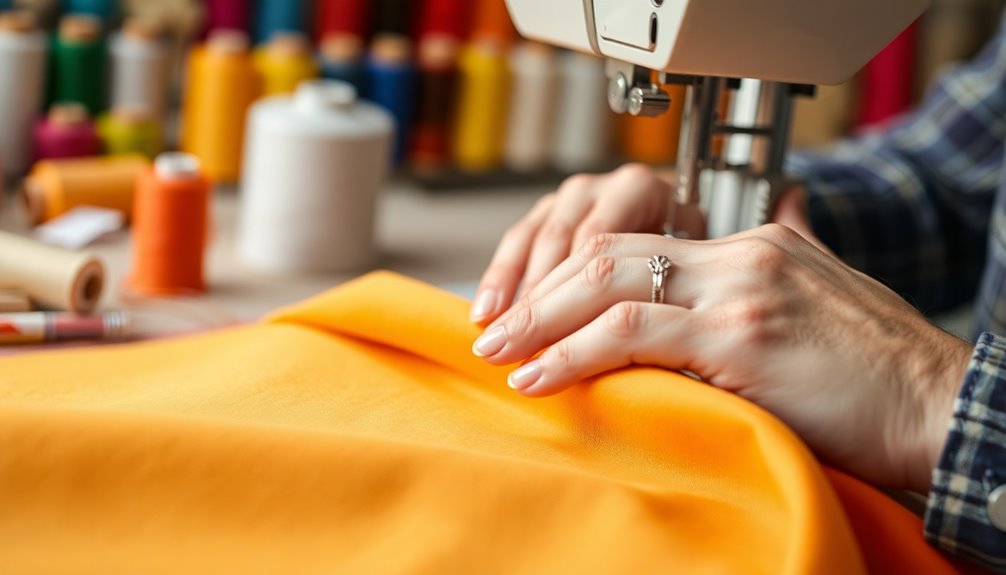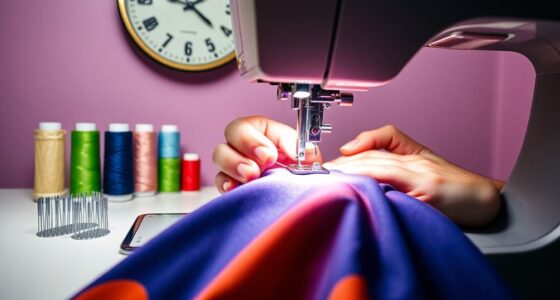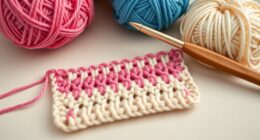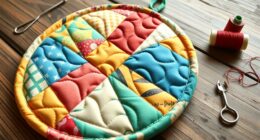To secure your fabric quickly with invisible stitching, start by preparing your fabric—iron the edges for a smooth finish. Then, use doubled thread to create discreet seams using the ladder stitch technique. Make sure to pull the thread taut to guarantee strength and minimize visible stitches. Finally, bury the knot within the fabric layers for a polished look. There's more to mastering this technique that can elevate your sewing skills to the next level!
Key Takeaways
- Use the invisible stitch technique for discreet seams, ensuring a professional finish without visible stitches on your fabric.
- Start by ironing fabric edges to create a smooth surface, which is crucial for effective stitching.
- Employ a sharp needle and matching thread to enhance the appearance and durability of your stitches.
- Follow the step-by-step technique to create secure stitches, hiding knots and ensuring a neat finish.
- Avoid common mistakes like excessive thread length and tight pulling to maintain even stitching and prevent puckering.
Understanding the Invisible Stitch Technique

The invisible stitch technique, often referred to as the ladder stitch, is a game-changer when it comes to hand sewing. This method creates discreet seams that allow you to close openings in fabric without visible stitches.
To start, iron the seam location and thread a needle with doubled thread for added strength. Confirm your knot is hidden within the fabric.
As you work, slide the needle through the top of the fold on one side, picking up small amounts of fabric on both sides, keeping everything aligned. The thread pulls taut, resembling rungs on a ladder, making the seam nearly invisible.
Finally, to secure your stitch, create a tight knot and hide the tail before snipping, achieving a professional finish.
Preparing Your Fabric for Sewing
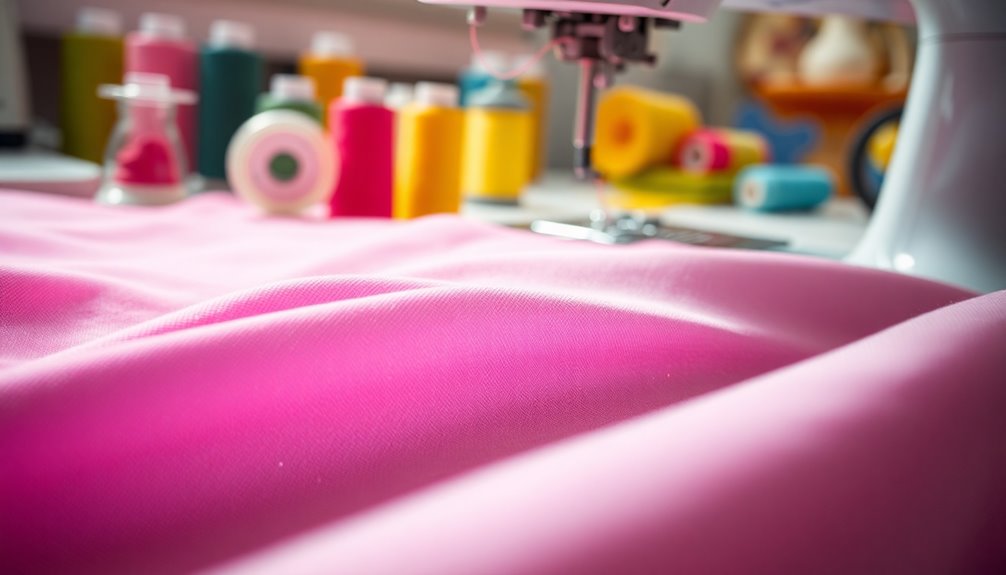
Before you start sewing, it's essential to iron the fabric edges to create a smooth surface that makes stitching easier.
Once that's done, thread your needle and secure a knot at the end to keep everything in place.
These simple steps will set you up for a successful sewing experience. Additionally, understanding effective communication strategies can improve your interactions during other life challenges, such as divorce.
Ironing Fabric Edges
Getting your fabric edges ready for sewing is essential for achieving a polished final product.
First, make certain you select the right iron temperature based on your fabric type to avoid any damage. Lay your fabric flat on the ironing board, aligning the edges smoothly for accurate stitching. A little bit of steam or a damp cloth can help set the fabric and eliminate creases.
Remember to gently press the edges without dragging the iron, as this can distort the shape and affect seam alignment. After pressing, allow the fabric to cool slightly to maintain the shape and guarantee a crisp edge before you start sewing. Additionally, using color accuracy in your fabric selection can enhance the overall appearance of your finished project.
Taking these steps will lead to a more professional finish in your sewing projects.
Threading the Needle
Once your fabric edges are pressed and ready, it's time to thread the needle and prepare for sewing.
Begin by ironing or hand pressing the fabric at the seam location to guarantee a smooth surface. Thread the needle with a doubled length of thread for added strength and create a knot at the end to secure it.
To conceal the knot, bring the needle up through the ironed edge of the fabric. Align the fabric edges neatly to facilitate an even, clean stitch as you proceed.
As you stitch, make certain the thread stays perpendicular to the fabric folds; this will help achieve that desired invisible stitch effect, assuring your stitching remains discreet and secure.
Happy sewing!
Mastering the Stitching Process
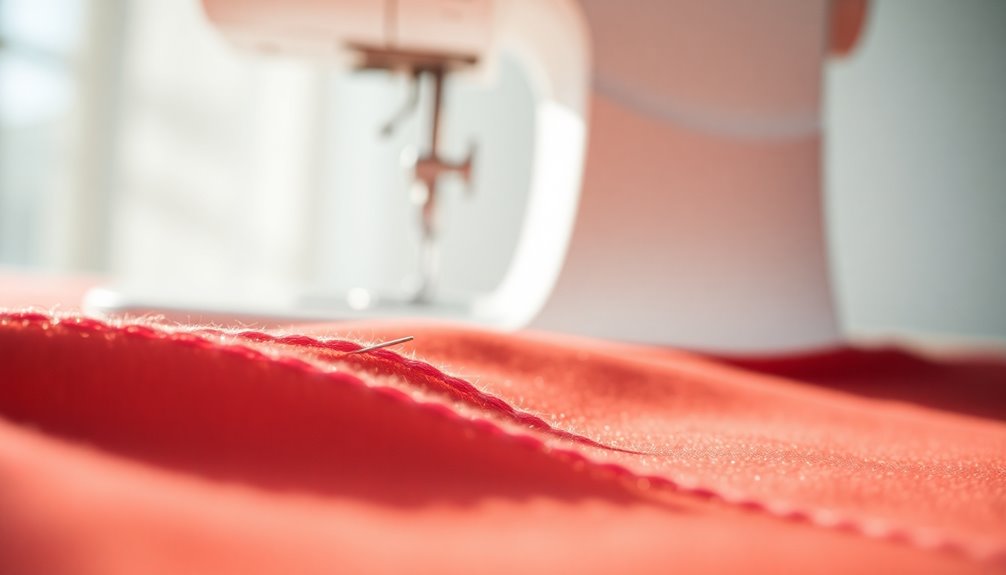
To master the stitching process, you'll need a few essential tools at your fingertips.
Follow a step-by-step technique to guarantee your stitches remain invisible and learn to sidestep common mistakes that could compromise your work.
Let's get started on perfecting your invisible stitching skills!
Essential Tools Needed
Having the right tools can make all the difference when mastering invisible stitching. To guarantee your stitching process goes smoothly, gather these essential items:
- Sharp Needle: Choose a fine needle suited for your fabric type to minimize damage and enable effortless stitching.
- Matching Thread: Select a thread that matches your fabric color. Doubling the thread adds strength and durability.
- Ironing Tools: Keep an iron or hand press ready to pre-press fabric edges at the seam location, making your stitching more precise.
- Sharp Scissors: Have a pair of sharp fabric scissors on hand for trimming excess thread and achieving clean edges post-stitching.
Additionally, understanding financial considerations can help you plan for potential costs associated with sewing projects.
With these tools, you'll set yourself up for success in achieving flawless invisible stitching!
Step-by-Step Technique
Mastering the invisible stitch requires a clear, step-by-step approach to guarantee your seams are nearly undetectable.
Start by preparing your fabric; iron or hand press the seam location for smooth edges. Next, thread your needle and create a knot at the end, doubling the thread for extra strength. Hide the knot within the fabric fold.
As you stitch, slide the needle through the top of the fold on the opposite side, picking up small amounts of fabric on each side to maintain a ladder-like appearance. Continue until you reach the end, securing the last stitch by knotting through the loop.
Finally, hide the thread tail within the fabric and snip it off, achieving a professional finish.
Common Mistakes to Avoid
While invisible stitching can elevate your sewing projects, several common mistakes can hinder your results. Avoid these pitfalls to achieve a flawless finish:
- Improper Fabric Preparation: Always verify the fabric edges are pressed and even before starting. This prevents uneven stitching and puckering.
- Excessive Thread Length: Don't use too much thread at once. While doubling it adds strength, too much can tangle and complicate your work.
- Inconsistent Stitch Size: Make sure you pick up equal amounts of fabric on each side. This keeps your stitches uniform.
- Tight Thread Pulling: Avoid pulling the thread too tightly, as it can lead to puckering instead of a smooth finish.
Additionally, using the right essential oils for relaxation can help create a calm sewing environment, enhancing focus and precision in your stitching process.
Securing Your Stitching With Knots
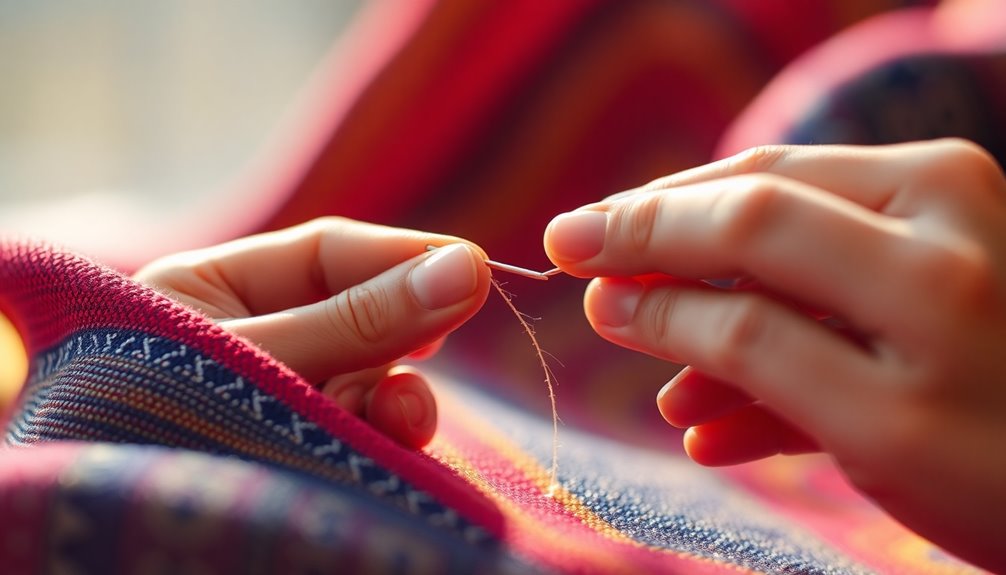
Securing your stitching with knots is vital for achieving a polished finish in any sewing project. To create a secure knot, pull the needle through the loop of thread after your final stitch, keeping the fabric tightly closed. For added durability, repeat this knotting process at least two times. It's important to maintain tension on the thread while knotting to avoid slack, which can cause loose stitches. Remember to hide the final knot by going down through it and exiting through the side of the fabric for a clean finish. A tight and secure knot will guarantee your invisible stitches hold up over time.
| Step | Description |
|---|---|
| 1. Create Knot | Pull needle through loop after last stitch. |
| 2. Repeat | Knot at least two times for durability. |
| 3. Maintain Tension | Keep thread taut to avoid slack. |
| 4. Hide Knot | Exit through the side of the fabric. |
Finalizing Your Invisible Stitch
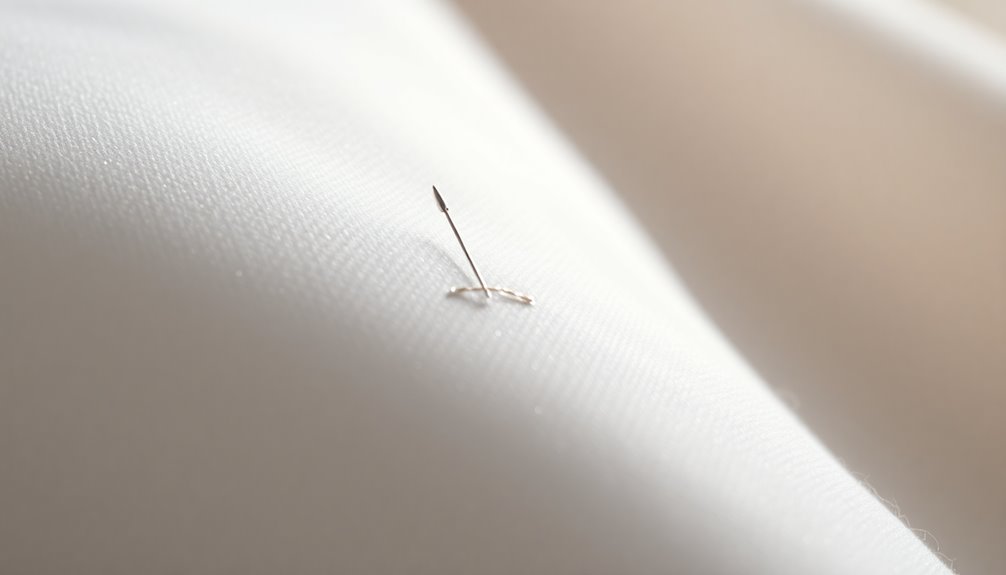
Once you've completed your invisible stitch, finalizing it properly is essential to guarantee a flawless appearance.
Here's how to do it effectively:
- Consistent Stitching: Pick up the fabric at the end in the same manner as your previous stitches for a uniform look.
- Secure the Knot: Create a secure knot by bringing the needle through the loop of thread and pulling tight to reinforce the seam.
- Double Up: For added security, repeat the knotting process a couple of times to prevent unraveling over time.
- Hide the Tail: Maneuver the needle down through the knot and exit through the side of the fabric, then snip the thread close to achieve a clean, nearly invisible finish.
With these steps, your invisible stitch will be secure and seamless!
Tips for a Professional Finish
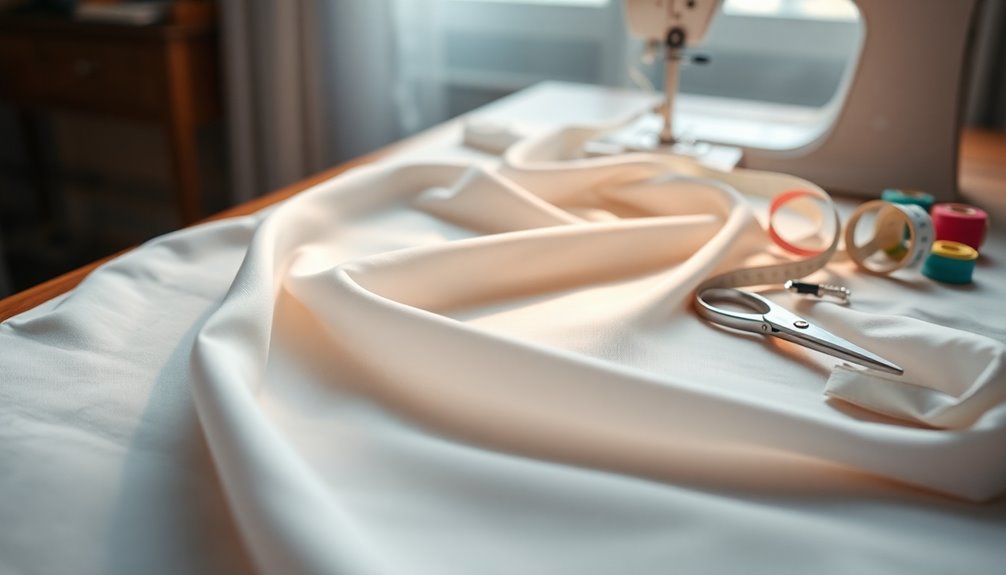
Achieving a polished look involves more than just mastering the invisible stitch; it also requires attention to detail in your finishing techniques.
Start by confirming your fabric edges are properly pressed, which creates a smooth seam. Use a doubled thread for added strength, helping maintain the stitch's integrity over time.
While stitching, keep your thread perpendicular to the fabric folds to guarantee neat, hidden stitches. When you finish, secure the final knot tightly and consider reinforcing it to prevent unraveling.
Finally, for an ideal finish, bury the thread tail within the fabric layers before cutting it. This way, you'll verify no loose ends are visible, leaving your project looking professional and well-crafted.
Frequently Asked Questions
How to Do the Invisible Stitch?
To do the invisible stitch, start by ironing your fabric's seam location.
Thread a needle with doubled thread for strength. Bring the needle up through the edge, hiding the knot inside.
Slide it through the top fold on the opposite side, picking up small amounts of fabric from each side. Keep stitching until you reach the end, then secure the thread with a knot.
Finally, hide the thread tail for a seamless finish.
What Stitch Is Known as the Hidden Stitch?
Imagine a secret door closing softly, leaving no trace behind. That's the beauty of the hidden stitch, often called the invisible stitch.
It's your go-to technique for achieving seamless finishes in sewing projects, creating nearly invisible seams that keep your work looking polished.
By carefully slipping your needle through folds of fabric, you'll master this artful stitch.
What Is the Name of the Hidden Stitch?
The hidden stitch is often called the invisible stitch. This technique lets you create seams that are nearly undetectable, making it perfect for closing fabric items like pillow covers and hems.
You'll find it's particularly useful when you want a professional finish without visible stitches. By carefully picking up small amounts of fabric from each side, you can achieve that seamless look effortlessly.
It's a great skill to have in your sewing toolkit!
Can You Get Invisible Stitches?
Yes, you can definitely get invisible stitches! By using the ladder stitch technique, you'll create seams that blend seamlessly into the fabric.
Make sure you prepare your fabric properly and use doubled thread for strength. As you stitch, slide the needle through the top fold and pick up small amounts of fabric on either side.
Pull the thread taut to hide the stitches, and finish by securing with a knot for a polished look.
Conclusion
Now that you're equipped with the invisible stitch technique, why not give your fabric projects a polished finish? With just a little practice, you can create seamless, professional-looking hems that'll impress everyone. Remember, taking the time to prepare your fabric and secure your stitches will pay off in the long run. So grab your needle and thread, and transform your sewing game today! You've got this!
